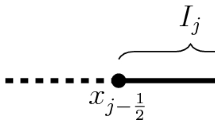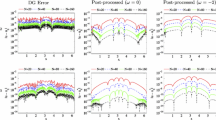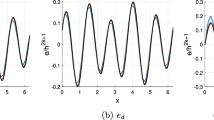Abstract
We further investigate the high order positivity-preserving discontinuous Galerkin (DG) methods for linear hyperbolic and radiative transfer equations developed in Yuan et al. (SIAM J Sci Comput 38:A2987–A3019, 2016). The DG methods in Yuan et al. (2016) can maintain positivity and high order accuracy, but they rely both on the scaling limiter in Zhang and Shu (J Comput Phys 229:8918–8934, 2010) and a rotational limiter, the latter may alter cell averages of the unmodulated DG scheme, thereby affecting conservation. Even though a Lax–Wendroff type theorem is proved in Yuan et al. (2016), guaranteeing convergence to weak solutions with correct shock speed when such rotational limiter is applied, it would still be desirable if a conservative DG method without changing the cell averages can be obtained which has both high order accuracy and positivity-preserving capability. In this paper, we develop and analyze such a DG method for both linear hyperbolic equations and radiative transfer equations. In the one-dimensional case, the method uses traditional DG space \(P^k\) of piecewise polynomials of degree at most k. A key result is proved that the unmodulated DG solver in this case can maintain positivity of the cell average if the inflow boundary value and the source term are both positive, therefore the positivity-preserving framework in Zhang and Shu (2010) can be used to obtain a high order conservative positivity-preserving DG scheme. Unfortunately, in two-dimensions this is no longer the case. We show that the unmodulated DG solver based either on \(P^k\) or \(Q^k\) spaces (piecewise kth degree polynomials or piecewise tensor-product kth degree polynomials) could generate negative cell averages. We augment the DG space with additional functions so that the positivity of cell averages from the unmodulated DG solver can be restored, thereby leading to high order conservative positivity-preserving DG scheme based on these augmented DG spaces following the framework in Zhang and Shu (2010). Computational results are provided to demonstrate the good performance of our DG schemes.










Similar content being viewed by others
References
Carlson, B.G., Lathrop, K.D.: Transport theory-the method of discrete ordinates. In: Greenspan, H., Kelber, C.N., Okrent, D. (eds.) Computing Methods in Reactor Physics, pp. 165–266. Gordon and Breach, New York (1968)
Cockburn, B., Hou, S., Shu, C.-W.: The Runge–Kutta local projection discontinuous Galerkin finite element method for conservation laws IV: the multidimensional case. Math. Comput. 54, 545–581 (1990)
Cockburn, B., Lin, S.-Y., Shu, C.-W.: TVB Runge–Kutta local projection discontinuous Galerkin finite element method for conservation laws III: one dimensional systems. J. Comput. Phys. 84, 90–113 (1989)
Cockburn, B., Shu, C.-W.: TVB Runge-Kutta local projection discontinuous Galerkin finite element method for conservation laws II: General framework. Math. Comput. 52, 411–435 (1989)
Cockburn, B., Shu, C.-W.: The Runge–Kutta discontinuous Galerkin method for conservation laws V: multidimensional systems. J. Comput. Phys. 141, 199–224 (1998)
Fiveland, W.A.: Discrete-ordinates solutions of the radiative transport equation for rectangular enclosures. J. Heat Transf. 106, 699–706 (1984)
Lathrop, K.D., Carlson, B.G.: Discrete Ordinate Angular Quadrature of the Neutron Transport equation. Technical report LA-3186, Los Alamos Scientific Laboratory (1965)
Lesaint, P., Raviart, P.A.: On a finite element method for solving the neutron transport equation. In: de Boor, C.A. (ed.) Mathematical Aspects of Finite Elements in Partial Differential Equations, pp. 89–145. Academic Press, New York (1974)
Lewis, E.E., Miller Jr., W.F.: Computational Methods of Neutron Transport. Wiley, New York (1984)
Qin, T., Shu, C.-W.: Implicit positivity-preserving high order discontinuous Galerkin methods for conservation laws. SIAM J. Sci. Comput. 40, A81–A107 (2018)
Reed, W.H., Hill, T.R.: Triangular mesh methods for the neutron transport equation. Technical report LA-UR-73-479, Los Alamos Scientific Laboratory (1973)
Shu, C.-W.: TVB uniformly high order schemes for conservation laws. Math. Comput. 49, 105–121 (1987)
Shu, C.-W., Osher, S.: Efficient implementation of essentially non-oscillatory shock-capturing schemes. J. Comput. Phys. 77, 439–471 (1988)
Yuan, D., Cheng, J., Shu, C.-W.: High order positivity-preserving discontinuous Galerkin methods for radiative transfer equations. SIAM J. Sci. Comput. 38, A2987–A3019 (2016)
Zhang, X., Shu, C.-W.: On positivity-preserving high order discontinuous Galerkin schemes for compressible Euler equations on rectangular meshes. J. Comput. Phys. 229, 8918–8934 (2010)
Author information
Authors and Affiliations
Corresponding author
Additional information
Juan Cheng: Research is supported in part by NSFC Grant 11471049 and U1630247 and Science Challenge Project No. TZ2016002. Chi-Wang Shu: Research is supported in part by ARO Grant W911NF-15-1-0226 and NSF Grant DMS-1719410.
Appendices
Appendix A: The Specific Test Function v for the Augmented DG Spaces
In this appendix we give explicit formulas for the specific test function v satisfying (4.1) for the augmented DG space \(R^1\) defined in (4.5). Since we just consider the case \(\alpha ,\beta >0\) in (2.7), we can simplify it as \(\alpha u_x+u_y+\gamma u=f\). Besides, for the DG scheme (2.8), we also take the size of the cell \(S_{i,j}\) as \(\Delta x_i=\Delta y_j\), which will only effect the ratio of \(\alpha \) and \(\beta \). The formula for v is then given as
where \(\varLambda _{i,j}\) reads as
with \({\widetilde{\gamma }}=\gamma \Delta x_i\) and
We can easily prove that the functions \(f_k(\xi ,\eta ),k=1,\dots ,6\) are all positive when \((\xi ,\eta )\in [-1,1]^2\). Hence \(v(\xi ,\eta )\) is positive on \(S_{i,j}\).
Appendix B
In this appendix we prove that, for the unmodulated DG scheme, all the upstream solution values at the interfaces \(u_{i+\frac{1}{2}}^-\) remain positive, when the physical inflow condition and the source term are both positive and when the mesh size h is small enough. Consider the case for \(\alpha >0\) in (2.1), then (2.1) can simplified as \(u_x+\gamma u=f\). By means of the similar technique utilized before, we would like to seek a special test function which satisfies
with \(\delta _k(x)\) defined in (3.1). Thanks to Lemma 3.1, we obtain an ordinary differential equation for v as follows:
Once again, the fact that v(x) is a polynomial with degree of k enables us to formulate v(x) explicitly by the form of
Obviously, v(x) is positive when \(\gamma =0\). Now let us analyze the case \(\gamma >0\). We can express \(\delta _k^{(l)}(x)\) more explicitly as follows
Meanwhile, we can reformulate v(x) as
Here we notice that \(p_k^{(k)}(\xi )=p_k^{(k)}(1)\) is a positive constant, which reads as
since \(p_k(\xi )=\frac{1}{2^k\cdot k!}\frac{d^n}{d\xi ^n}(\xi ^2-1)^k\). Therefore, when the mesh size \(\Delta x_i\) is small enough, v(x) will be positive with a value close to 1.
For smaller k, we also list the range of \(\gamma \Delta x_i\) to ensure the positivity of v. Let us denote \({\widetilde{\gamma }}=\gamma \Delta x_i\) once again. We can write v out as a function of the variable \(\xi \) for the cases \(k=1,2,3,4\) as follows:
-
(1)
\(k=1\):
$$\begin{aligned} v(\xi )=\frac{6+{\widetilde{\gamma }}+3{\widetilde{\gamma }}\xi }{6+4{\widetilde{\gamma }}+{\widetilde{\gamma }}^2}. \end{aligned}$$It turns out that \(v(\xi )\ge 0\) if \({\widetilde{\gamma }}\le 3\).
-
(2)
\(k=2\):
$$\begin{aligned} v(\xi )=\frac{120+12{\widetilde{\gamma }}(1+5\xi ) +3{\widetilde{\gamma }}^2(-1+2\xi +5\xi ^2)}{120+72{\widetilde{\gamma }} +18{\widetilde{\gamma }}^2+2{\widetilde{\gamma }}^3}. \end{aligned}$$\(v(\xi )\) will be non-negative when \({\widetilde{\gamma }}\le 5\sqrt{\frac{2}{3}}\).
-
(3)
\(k=3\):
$$\begin{aligned} v(\xi )=\frac{1680+120{\widetilde{\gamma }}(1+7\xi ) +30{\widetilde{\gamma }}^2(-1+2\xi +7\xi ^2) +{\widetilde{\gamma }}^3(-3-15\xi +15\xi ^2+35\xi ^3)}{1680+960{\widetilde{\gamma }}+240{\widetilde{\gamma }}^2 +32{\widetilde{\gamma }}^3+2{\widetilde{\gamma }}^4}. \end{aligned}$$When \({\widetilde{\gamma }}\le 5-\frac{5^{2/3}}{(1+\sqrt{6})^{1/3}}+\big (5(1+\sqrt{6})\big )^{1/3}\approx 5.6484\) we have \(v(\xi )\ge 0\).
-
(4)
\(k=4\):
$$\begin{aligned}\begin{aligned} v(\xi )&=\frac{5}{\Lambda }\big (24192+1344{\widetilde{\gamma }} (1+9\xi )+336{\widetilde{\gamma }}^2(-1+2\xi +9\xi ^2)\\&+\,24{\widetilde{\gamma }}^3(-1-7\xi +7\xi ^2+21 \xi ^3) +{\widetilde{\gamma }}^4(3-12\xi -42\xi ^2+28\xi ^3+63\xi ^4)\big ) \end{aligned} \end{aligned}$$where
$$\begin{aligned} \Lambda =8(15120+8400{\widetilde{\gamma }}+2100{\widetilde{\gamma }}^2 +300{\widetilde{\gamma }}^3+25{\widetilde{\gamma }}^4 +{\widetilde{\gamma }}^5). \end{aligned}$$It is easy to prove that \(v(\xi )\ge 0\) if
$$\begin{aligned} {\widetilde{\gamma }}\le \frac{1}{2}\left( 7-\frac{11\cdot 7^{2/3}}{(3(81+4\sqrt{2157}))^{1/3}} +\frac{(7(81+4\sqrt{2157}))^{1/3}}{3^{2/3}}\right) \approx 4.2923. \end{aligned}$$
Rights and permissions
About this article
Cite this article
Ling, D., Cheng, J. & Shu, CW. Conservative High Order Positivity-Preserving Discontinuous Galerkin Methods for Linear Hyperbolic and Radiative Transfer Equations. J Sci Comput 77, 1801–1831 (2018). https://doi.org/10.1007/s10915-018-0700-3
Received:
Revised:
Accepted:
Published:
Issue Date:
DOI: https://doi.org/10.1007/s10915-018-0700-3




